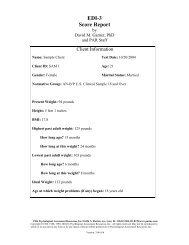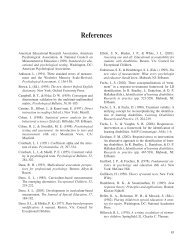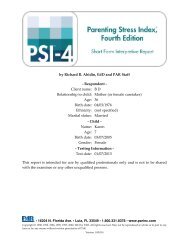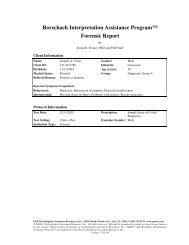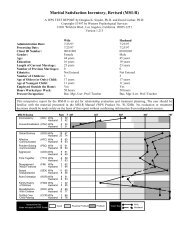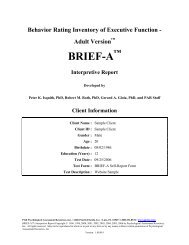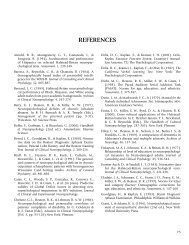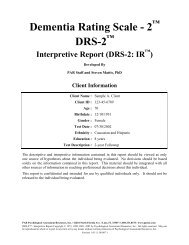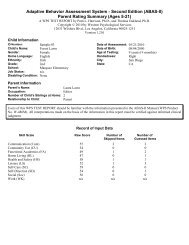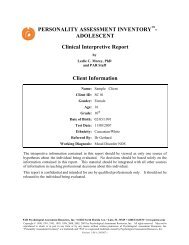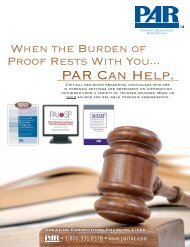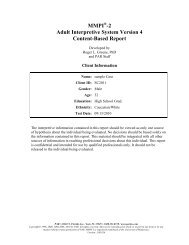References - Psychological Assessment Resources, Inc.
References - Psychological Assessment Resources, Inc.
References - Psychological Assessment Resources, Inc.
You also want an ePaper? Increase the reach of your titles
YUMPU automatically turns print PDFs into web optimized ePapers that Google loves.
<strong>References</strong><strong>References</strong> marked with an asterisk indicate studies included in the data analyses.*Alwes, Y. R., Clark, J. A., Berry, D. T. R., & Granacher,R. P. (2008). Screening for feigning in a civil forensicsetting. Journal of Clinical and Experimental Neuro -psychology, 30, 133-140.American Counseling Association. (2005). ACA code ofethics. Retrieved from http://www.counseling.org/resources/codeofethics/tp/home/ct2.aspxAmerican Educational Research Association, American<strong>Psychological</strong> Association, & National Council onMeasurement in Education. (1999). Standards for educationaland psychological testing. Washington, DC:Authors.American Psychiatric Association. (1980). Diagnostic andstatistical manual of mental disorders (3rd ed.).Washington, DC: Author.American Psychiatric Association (1987). Diagnostic andstatistical manual of mental disorders (3rd ed.-rev.).Washington, DC: author.American Psychiatric Association. (2000). Diagnostic andstatistical manual of mental disorders (4th ed., text rev.).Washington, DC: Author.American Psychiatric Association. (2008). The principlesof medical ethics with annotations especially applicableto psychiatry. Washington, DC: Author. Retrievedfrom http://www.psych.org/mainmenu/psychiatricpractice/ethics/resourcesstandards/principlesofmedicalethics.aspxAmerican <strong>Psychological</strong> Association (2002). Ethical principlesof psychologists and code of conduct. AmericanPsychologist, 57, 1060-1073.American <strong>Psychological</strong> Association, Committee onLegal Issues (2006). Strategies for private practitionerscoping with subpoenas or compelled testimony forclient records or test data. Professional Psychology:Research and Practice, 37, 215-222. doi: 10.1037/0735-7028.37.2.215American <strong>Psychological</strong> Association, Committee on<strong>Psychological</strong> Tests and Measures (1996). Statementon the disclosure of test data. American Psychologist,51, 644-648.Anastasi, A. (1988). <strong>Psychological</strong> testing (6th ed.). NewYork, NY: Macmillan.Archer, R. P., Buffington-Vollum, J. K., Stredny, R. V., &Handel, R. W. (2006). A survey of psychological testuse patterns among forensic psychologists. Journal ofPersonality <strong>Assessment</strong>, 87, 84-94.Baer, R., Wetter, M., & Berry, D. (1992). Detection ofunderreporting of psychopathology on the MMPI: Ameta-analysis. Clinical Psychology Review, 12, 509-525.Ben-Porath, Y. S., & Tellegen, A. (2008). MinnesotaMulti phasic Personality Inventory–2 Restructured Form:Manual for administration, scoring, and interpretation.Minneapolis, MN: University of Minnesota Press.Berry, D. T., & Schipper, L. J. (2008). <strong>Assessment</strong> offeigned cognitive impairment using standard neuropsychologicaltests. In R. Rogers (Ed.), Clinicalassessment of malingering and deception (3rd ed.,pp. 237-252). New York, NY: Guilford Press.Binder, L. M. (1993). <strong>Assessment</strong> of malingering aftermild head trauma with the Portland Digit RecognitionTest. Journal of Clinical and Experimental Neuropsy -chology, 15, 170-182.*Boccaccini, M. T., Murrie, D. C., & Duncan, S. A.(2006). Screening for malingering in a criminalforensicsample with the Personality <strong>Assessment</strong> Inven -tory. <strong>Psychological</strong> <strong>Assessment</strong>, 18, 415-423.Boone, K. B., Lu, P., & Herzberg, D. (2002). The b TestManual. Los Angeles, CA: Western <strong>Psychological</strong>Services.*Brand, B. L., McNary, S. W., Loewenstein, R. J., Kolos,A. C., & Barr, S. R. (2006). <strong>Assessment</strong> of genuine andsimulated dissociative identity disorder on the Struc -tured Interview of Reported Symptoms. Journal ofTrauma & Dissociation, 7, 63-85.Butcher, J. N., Dahlstrom, W. G., Graham, J. R., Tellegen, A.,& Kaemmer, B. (1989). Minnesota Multiphasic Person -ality Inventory–2 (MMPI-2): Manual for administrationand scoring. Minneapolis, MN: University of MinnesotaPress.99
Cirincione, C., Steadman, H. J., & McGreevy, M. A. (1995).Rates of insanity acquittals and the factors associatedwith successful insanity pleas. Bulletin of the AmericanAcademy of Psychiatry & the Law, 23, 399-409.Cohen, J. (1988). Statistical power analysis for the behavioralsciences (2nd ed.). Hillsdale, NJ: Erlbaum.*Connell, D. K. (1991). The SIRS and the M test: The differentialvalidity and utility of two instruments designedto detect malingered psychosis in a correctional sample.(Unpublished doctoral dissertation). University ofLouisville, Louisville, KY.Correa, A. A., & Rogers, R. (2008). Cross-cultural applicationsof the PAI. Manuscript in preparation.Correa, A. A., Rogers, R., & Hoersting, R. (2009). Valida -tion of the Spanish SIRS with monolingual Hispanic outpatients.Manuscript submitted for publication.Dahlstrom, W. G., Welsh, G. S., & Dahlstrom, L. E.(1972). An MMPI handbook: Vol. I: Clinical interpretation(Rev. ed.). Minneapolis, MN: University ofMinnesota Press.Dixon, D. N. (1995). Test review of the StructuredInterview of Reported Symptoms. In Conoley, J. C. &Impara, J. C. (Eds.), The twelfth mental measurementsyearbook [Electronic version]. Retrieved from theBuros Institute’s Test Reviews Online Web site:http://www.unl.edu/buros*Eakin, D. E. (2005). Detection of feigned posttraumaticstress disorder: A multimodal assessment strategy.(Unpublished doctoral dissertation). Auburn Univer -sity, Auburn, AL.Edens, J. F., Poythress, N. G., & Watkins-Clay, M. M.(2007). Detection of malingering in psychiatric unitand general population prison inmates: A comparisonof the PAI, SIMS, and SIRS. Journal of Personality<strong>Assessment</strong>, 88, 33-42. doi: 10.1080/00223890709336832Erard, R. E. (2004). Release of test data under the 2002ethics code and the HIPAA privacy rule: A raw deal orjust a half-baked idea? Journal of Personality <strong>Assessment</strong>,82, 23-30. doi: 10.1207/s15327752jpa8201_4Fantoni-Salvador, P., & Rogers, R. (1997). Spanish versionsof the MMPI-2 and PAI: An investigation of concurrentvalidity with Hispanic patients. <strong>Assessment</strong>, 4,29-39.First, M. B., Gibbon, M. Spitzer, R. L., & Williams, J. B.(1997). Structured Clinical Interview for DSM-IV Axis IIPersonality Disorders (SCID-II): User’s guide. Washington,DC: American Psychiatric Publishing.First, M. B., Spitzer, R. L, Gibbon, M., and Williams,J. B. W. (1996). Structured Clinical Interview forDSM-IV Axis I Disorders, Clinician Version (SCID-CV).Washington, DC: American Psychiatric Press.*Gassen, M. D., Pietz, C. A., Spray, B. J., & Denney, R. L.(2007). Accuracy of Megargee’s criminal offenderinfrequency (Fc) scale in detecting malingeringamong forensic examinees. Criminal Justice andBehavior, 34, 493-504.*Goodness, K. R. (2000). Retrospective evaluation ofmalingering: A validational study of the R-SIRS andCT-SIRS. Dissertation Abstracts International: Section B:The Sciences and Engineering, 60(9), 4888.*Gothard, S., Viglione, D. J., Meloy, J. R., & Sherman, M.(1995). Detection of malingering in competency tostand trial evaluations. Law and Human Behavior, 19,493-505.*Green, D., Rosenfeld, B., Dole, T., Pivovarova, E., &Zapf, P. A. (2008). Validation of an abbreviated versionof the Structured Interview of ReportedSymptoms in outpatient psychiatric and communitysettings. Law and Human Behavior, 32, 177-186. doi:10.1007/s10979-007-9089-5Greene, R. L. (1980). The MMPI: An interpretive manual.New York, NY: Grune & Stratton.Greene, R. L. (2000). The MMPI-2: An interpretive manual(2nd ed.). Needham Heights, MA: Allyn & Bacon.Greene, R. L. (2008). Malingering and defensiveness onthe MMPI-2. In R. Rogers (Ed.), Clinical assessment ofmalingering and deception (3rd ed., pp. 159-181). NewYork, NY: Guilford Press.*Guy, L. S., & Miller, H. A. (2004). Screening for malingeredpsychopathology in a correctional setting:Utility of the Miller-Forensic <strong>Assessment</strong> of SymptomsTest (M-FAST). Criminal Justice and Behavior, 31, 695-716. doi: 10.1177/0093854804268754Hambleton, R. K. (2001). The next generation of theITC test translation and adaptation guidelines. EuropeanJournal of <strong>Psychological</strong> <strong>Assessment</strong>, 17, 164-172.Hamilton, J. C., Feldman, M. D., & Cunnien, A. J. (2008).Factitious disorder in medical and psychiatric practices.In R. Rogers (Ed.), Clinical assessment of malingeringand deception (3rd ed., pp. 128-144). New York,NY: Guilford Press.Hathaway, S. R. & McKinley, J. C. (1943). The MinnesotaMultiphasic Personality Inventory. Minneapolis, MN:University of Minnesota Press.100
*Hayes, J. S., Hale, D. B., & Gouvier, W. D. (1998).Malingering detection in a mentally retarded forensicpopulation. Applied Neuropsychology, 5, 33-36. doi:10.1207/s15324826an0501_4Heilbrun, K., Bennett, W. S., White, A. J., & Kelly, J.(1990). An MMPI-based empirical model of malingeringand deception. Behavioral Sciences & the Law,8, 45-53. doi: 10.1002/bsl.2370080106*Heinze, M. C. (2003). Developing sensitivity to distortion:Utility of psychological tests in differentiatingmalingering and psychopathology in criminal defendants.Journal of Forensic Psychiatry & Psychology, 14,151-177. doi: 10.1080/1478994031000077961*Heinze, M. C., & Purisch, A. D. (2001). Beneath themask: Use of psychological tests to detect and subtypemalingering in criminal defendants. Journal of ForensicPsychology Practice, 1, 23-52.*Jackson, R. L., Rogers, R., & Sewell, K. W. (2005).Forensic applications of the Miller Forensic Assess -ment of Symptoms Test (M-FAST): Screening forfeigned disorders in competency to stand trial evaluations.Law and Human Behavior, 29, 199-210. doi:10.1007/s10979-005-2193-5*Kropp, P. R. (1992). The relationship between psychopathyand malingering of mental illness. (Unpublisheddoctoral dissertation). Simon Fraser University,Vancouver, British Columbia, Canada.*Kucharski, L. T., & Duncan, S. (2006). Clinical anddemographic characteristics of criminal defendantspotentially misidentified by objective measures ofmalingering. American Journal of Forensic Psychology,24, 5-20.*Kucharski, L. T., & Duncan, S. (2007). Differentiationof mentally ill criminal defendants from malingererson the MMPI-2 and PAI. American Journal of ForensicPsychology, 25, 21-42.*Kucharski, L. T., Duncan, S., Egan, S. S., & Falkenbach,D. M. (2006a). Psychopathy and malingering of psychiatricdisorder in criminal defendants. BehavioralSciences & the Law, 24, 633-644. doi: 10.1002/bsl.661Kucharski, L. T., Duncan, S., Egan, S. S., & Falkenbach,D. M. (2006b). ‘Psychopathy and malingering of psychiatricdisorder in criminal defendants’: Erratum.Behavioral Sciences & the Law, 24, 717-717. doi:10.1002/bsl.733Kucharski, L. T., Falkenbach, D. M., Egan, S. S., &Duncan, S. (2006). Antisocial personality disorder andthe malingering of psychiatric disorder: A study ofcriminal defendants. International Journal of ForensicMental Health, 5, 195-204.*Kucharski, L. T., Toomey, J. P., Fila, K., & Duncan, S.(2007). Detection of malingering of psychiatric disorderwith the Personality <strong>Assessment</strong> Inventory: Aninvestigation of criminal defendants. Journal ofPersonality <strong>Assessment</strong>, 88, 25-32.*Kurtz, R. A. (1992). The vulnerability of the MMPI-2,M Test, and SIRS to two strategies of malingering psychosisin a forensic setting. (Unpublished doctoral dissertation).University of Louisville, Louisville, KY.Lally, S. J. (2003). What tests are acceptable for use inforensic evaluations? A study of experts. ProfessionalPsychology: Research and Practice, 34, 491-498.*Lewis, J. L., Simcox, A. M., & Berry, D. T. (2002).Screening for feigned psychiatric symptoms in a forensicsample by using the MMPI-2 and the StructuredInventory of Malingered Symptomatology. Psycho -logical <strong>Assessment</strong>, 14, 170-176.*Lindblad, A. D. (1993). Detection of malingered mentalillness with a forensic population: An analoguestudy. (Unpublished doctoral dissertation). Universityof Manitoba, Winnipeg, Canada.Marín, G., & Marín, B. (1991). Research with Hispanicpopulations. Newbury Park, CA: Sage.*McCusker, P. J., Moran, M. J., Serfass, L., & Peterson,K. H. (2003). Comparability of the MMPI-2 F(p) andF scales and the SIRS in clinical use with suspectedmalingerers. International Journal of Offender Therapyand Comparative Criminology, 47, 585-596. doi:10.1177/0306624X03254013Miller, H. A. (2001). M-FAST: Miller-Forensic <strong>Assessment</strong>of Symptoms Test professional manual. Odessa, FL:<strong>Psychological</strong> <strong>Assessment</strong> <strong>Resources</strong>.*Miller, H. A. (2004). Examining the use of the M-FASTwith criminal defendants incompetent to stand trial.International Journal of Offender Therapy and Compara -tive Criminology, 48, 268-280.*Miller, H. A. (2005). The Miller-Forensic <strong>Assessment</strong> ofSymptoms Test (M-FAST): Test generalizability andutility across race, literacy, and clinical opinion.Criminal Justice and Behavior, 32, 591-611. doi:10.1177/0093854805278805Millon, T. (1987). Millon Clinical Multiaxial Inventory-IIprofessional manual. Minneapolis, MN: NationalComputer Systems.Morey, L. C. (1991). The Personality <strong>Assessment</strong> Inventoryprofessional manual. Odessa, FL: <strong>Psychological</strong><strong>Assessment</strong> <strong>Resources</strong>.Morey, L. C. (2007). The Personality <strong>Assessment</strong> Inventoryprofessional manual (2nd ed.). Lutz, FL: <strong>Psychological</strong><strong>Assessment</strong> <strong>Resources</strong>.101
*Norris, M. P., & May, M. C. (1998). Screening for malingeringin a correctional setting. Law and HumanBehavior, 22, 315-323. doi: 10.1023/A:1025706606774Phillips, K. A., & Fallon, B. (2000). Somatoform and factitiousdisorders and malingering measures. In A. J.Rush, H. A. Pincus, M. B. First, D. Blacker, J. Endicott,S. J., Keith, et al. (Eds.), Handbook of psychiatric measures(pp. 591-616). Washington, DC: AmericanPsychiatric Press.*Pollock, P. H. (1996). A cautionary note on the determinationof malingering in offenders. Psychology,Crime & Law, 3, 97-110. doi: 10.1080/10683169608409798*Pollock, P. (1998). Feigning auditory hallucinations byoffenders. Journal of Forensic Psychiatry, 9, 305-327.Poythress, N. G., Edens, J. F., & Watkins, M. M. (2001).The relationship between psychopathic personalityfeatures and malingering symptoms of major mentalillness. Law and Human Behavior, 25, 567-582. doi:10.1023/A:1012702223004<strong>Psychological</strong> <strong>Assessment</strong> <strong>Resources</strong>, <strong>Inc</strong>. (PAR). (2004).Letter to customers regarding the Privacy Rule ofthe Health Insurance Portability and AccountabilityAct (HIPAA). Lutz, FL: Author. Retrieved fromhttp://www3.parinc.com/uploads/forms/633298695393052387_HIPAA%20Statement.pdfResnick, P. J., & Knoll, J. L. (2008). Malingered psychosis.In R. Rogers (Ed.), Clinical assessment of malingeringand deception (3rd ed, pp. 51-68). New York, NY:Guilford Press.Rhodes, A. E., Goering, P. N., To, T., & Williams, J. I.(2002). Gender and outpatient mental health serviceuse. Social Science & Medicine, 54, 1-10. doi:10.1016/S0277-9536(01)00002-8Rogers, R. (1984). Towards an empirical model of malingeringand deception. Behavioral Sciences and the Law,2, 93-111. doi: 10.1002/bsl.2370020109Rogers, R. (1987). <strong>Assessment</strong> of malingering within aforensic context. In D. N. Weisstub (Ed.), Law andmental health: An international perspective (Vol. 3,pp. 209-237). New York, NY: Pergamon Press.Rogers, R. (1988a). Introduction. In R. Rogers (Ed.),Clinical assessment of malingering and deception(pp. 1-9). New York, NY: Guilford Press.Rogers, R. (1988b). Structured interviews and dissimulation.In R. Rogers (Ed.), Clinical assessment of malingeringand deception (pp. 250-268). New York, NY:Guilford Press.Rogers, R. (1990a). Development of a new classificatorymodel of malingering. Bulletin of the AmericanAcademy of Psychiatry and the Law, 18, 323-33.Rogers, R. (1990b). Models of feigned mental illness.Professional Psychology: Research and Practice, 21,182-188.Rogers, R. (1997a). Introduction. In R. Rogers (Ed.),Clinical assessment of malingering and deception (2nded., pp. 1-19). New York, NY: Guilford Press.Rogers, R. (1997b). Researching dissimulation. InR. Rogers (Ed.), Clinical assessment of malingering anddeception (2nd ed., pp. 398-426). New York, NY:Guilford Press.Rogers, R. (1997c). Structured interviews and dissimulation.In R. Rogers (Ed.), Clinical assessment of malingeringand deception (2nd ed., pp. 301-327). New York,NY: Guilford Press.Rogers, R. (2001). Handbook of diagnostic and structuredinterviewing. New York, NY: Guilford Press.Rogers, R. (2003). Standardizing DSM-IV diagnoses: Theclinical applications of structured interviews. Journal ofPersonality <strong>Assessment</strong>, 81, 220-225.Rogers, R. (2004). APA 2002 ethics, amphibology, andthe release of psychological test records: A counterperspectiveto Erard. Journal of Personality <strong>Assessment</strong>,82, 31-34.Rogers, R. (2008a). An introduction to response styles.In R. Rogers (Ed.), Clinical assessment of malingeringand deception (3rd ed., pp. 3-13). New York, NY:Guilford Press.Rogers, R. (2008b). Current status of clinical methods.In R. Rogers (Ed.), Clinical assessment of malingeringand deception (3rd ed., pp. 391-410). New York, NY:Guilford Press.Rogers, R. (2008c). Detection strategies for malingeringand defensiveness. In R. Rogers (Ed.), Clinical assessmentof malingering and deception (3rd ed., pp. 14-35).New York, NY: Guilford Press.Rogers, R. (2008d). Researching response styles. InR. Rogers (Ed.), Clinical assessment of malingering anddeception (3rd ed., pp. 411-434). New York, NY:Guilford Press.Rogers, R. (2008e). Structured interviews and dissimulation.In R. Rogers (Ed.), Clinical assessment of malingeringand deception (3rd ed., pp. 301-322). New York,NY: Guilford Press.*Rogers, R., Bagby, R. M., & Dickens, S. E. (1992). Struc -tured Interview of Reported Symptoms professional manual.Odessa, FL: <strong>Psychological</strong> <strong>Assessment</strong> <strong>Resources</strong>.102
Rogers, R., Bagby, R. M., & Rector, N. (1989). Diagnosticlegitimacy of factitious disorder with psychologicalsymptoms. American Journal of Psychiatry, 146, 1312-1314.Rogers, R., Bagby, R. M., & Vincent, A. (1994). Factitiousdisorders with predominantly psychological signs andsymptoms: A conundrum for forensic experts. Journalof Psychiatry & Law, 22, 99-106.Rogers, R., & Bender, S. D. (2003). Evaluation of malingeringand deception. In A. M. Goldstein and I. B.Weiner (Eds.), Handbook of psychology: Forensic psychology(Vol. 11, pp. 109-129). New York, NY: Wiley.Rogers, R. & Correa, A. A. (2008). Determinations ofmalingering: Evolution from case-based methods todetection strategies. Psychiatry, Psychology, and Law,15, 213-223. doi: 10.1080/13218710802014501Rogers, R., & Cruise, K. R. (2000). Malingering anddeception among psychopaths. In C. B. Gacono (Ed.),The clinical and forensic assessment of psychopathy: Apractitioner’s guide (pp. 269-284). New York, NY:Erlbaum.*Rogers, R., Gillis, J. R., & Bagby, R. M. (1990). The SIRSas a measure of malingering: A validation study with acorrectional sample. Behavioral Sciences & the Law, 8,85-92. doi: 10.1002/bsl.2370080*Rogers, R., Gillis, J. R., Bagby, R. M., & Monteiro, E.(1991). Detection of malingering on the StructuredInterview of Reported Symptoms (SIRS): A study ofcoached and uncoached simulators. <strong>Psychological</strong><strong>Assessment</strong>: A Journal of Consulting and Clinical Psy -chology, 3, 673-677.*Rogers, R., Gillis, J. R., Dickens, S. E., & Bagby, R. M.(1991). Standardized assessment of malingering:Validation of the Structured Interview of ReportedSymptoms. <strong>Psychological</strong> <strong>Assessment</strong>: A Journal ofConsulting and Clinical Psychology, 3, 89-96.Rogers, R., Harrell, E. H., & Liff, C. D. (1993). Feigningneuropsychological impairment: A critical review ofmethodological and clinical considerations. ClinicalPsychology Review, 13, 255-274.*Rogers, R., Hinds, J. D., & Sewell, K. W. (1996). Feign -ing psychopathology among adolescent offenders:Validation of the SIRS, MMPI-A, and SIMS. Journal ofPersonality <strong>Assessment</strong>, 67, 244-257. doi: 10.1207/s15327752jpa6702_2Rogers, R., Jackson, R. L., & Kaminski, P. L. (2005).Factitious psychological disorders: The overlookedresponse style in forensic evaluations. Journal ofForensic Psychology Practice, 5, 21-41.Rogers, R., Jackson, R. L., Salekin, K. L., & Neumann, C. S.(2003). Assessing Axis I symptomatology on theSADS-C in two correctional samples: The validationof subscales and a screen for malingered presentations.Journal of Personality <strong>Assessment</strong>, 81, 281-290.doi: 10.1207/S15327752JPA8103_11*Rogers, R., Jackson, R. L., Sewell, K. W., & Harrison,K. S. (2004). An examination of the ECST-R as ascreen for feigned incompetency to stand trial.<strong>Psychological</strong> <strong>Assessment</strong>, 16, 139-145.*Rogers, R., Jackson, R. L., Sewell, K. W., & Salekin, K. L.(2005). Detection strategies for malingering: A confirmatoryfactor analysis of the SIRS. Criminal Justiceand Behavior, 32, 511-525.*Rogers, R., Kropp, P. R., Bagby, R. M., & Dickens, S. E.(1992). Faking specific disorders: A study of theStructured Interview of Reported Symptoms (SIRS).Journal of Clinical Psychology, 48, 643-648.Rogers, R., & Payne, J. W. (2006). Damages and rewards:<strong>Assessment</strong> of malingered disorders in compensationcases. Behavioral Sciences and the Law, 24, 645-658.*Rogers, R., Payne, J. W., Berry, D. T., & Granacher, Jr.,R. P. (2009). Use of the SIRS in compensation cases:An examination of its validity and generalizability.Law and Human Behavior, 33, 213-224.*Rogers, R. Payne, J. W., Correa, A. A., Gillard, N. D. &Ross, C. A. (2009). A study of the SIRS with severelytraumatized patients. Journal of Personality <strong>Assessment</strong>,91, 429-438.Rogers, R., & Reinhardt, V. (1998). Conceptualization andassessment of secondary gain. In G. P. Koocher, J. C.Norcross, & S. S. Hill (Eds.), Psychologist’s desk reference(pp. 57-62). New York: Oxford University Press.*Rogers, R., Salekin, R. T., Sewell, K. W., Goldstein, A., &Leonard, K. (1998). A comparison of forensic andnonforensic malingerers: A prototypical analysis ofexplanatory models. Law and Human Behavior, 22,353-367.*Rogers, R., Sewell, K. W., Cruise, K. R., Wang, E. W., &Ustad, K. L. (1998). The PAI and feigning: A cautionarynote on its use in forensic-correctional settings.<strong>Assessment</strong>, 5, 399-405.Rogers, R., Sewell, K. W., & Goldstein, A. (1994).Explanatory models of malingering: A prototypicalanalysis. Law and Human Behavior, 18, 543-552.*Rogers, R., Sewell, K. W., Grandjean, N. R., & Vitacco,M. J. (2002). The detection of feigned mental disorderson specific competency measures. <strong>Psychological</strong><strong>Assessment</strong>, 14, 177-183.103
Warren, J., Murrie, D. C., Chauhan, P., Dietz, P. E., &Morris, J. (2004). Opinion formation in evaluatingsanity at the time of the offense: An examination of5,175 pre-trial evaluations. Behavioral Sciences & theLaw, 22, 171-186. doi: 10.1002/bsl.559Warren, J. I., Murrie, D. C., Stejskal, W., Colwell, L. H.,Morris, J., Chauhan, P., & Dietz, P. (2006). Opinionformation in evaluating the adjudicative competenceand restorability of criminal defendants: A review of8,000 evaluations. Behavioral Sciences & the Law, 24,113-132. doi: 10.1002/bsl.699Wechsler, D.(2008). Wechsler Adult Intelligence Scale–Fourth Edition administration and scoring manual. SanAntonio: TX: Pearson Education.West, H. C., & Sabol, W. J. (2008). Prisoners in 2007.Bureau of Justice Statistics Bulletin (NCJ 224280).Retrieved from http://www.ojp.usdoj.gov/bjs/pub/pdf/p07.pdfWidows, M., & Smith, G. P. (2005). Structured Inventory ofMalingered Symptomatology (SIMS) professional manual.Odessa, FL: <strong>Psychological</strong> <strong>Assessment</strong> <strong>Resources</strong>.Wilkinson, L., & Task Force on Statistical Inference.(1999). Statistical methods in psychology journals:Guidelines and explanations. American Psychologist,54, 594-604.*Wynkoop, T. F., Frederick, R. I., & Hoy, M. (2006).Improving the clinical utility of the SIRS cognitiveitems: Preliminary reliability, validity, and normativedata in pretrial and clinical samples. Archives ofClinical Neuropsychology, 21, 651-656. doi:10.1016/j.acn.2006.06.009Zarin, D. A., Pincus, H. A., Peterson, B. D., West, J. C.,Suarez, A. P., Marcus, S. C., & McIntyre, J. S. (1998).Characterizing psychiatry with findings from the 1996National Survey of Psychiatric Practice. AmericanJournal of Psychiatry, 155, 397-404.105



